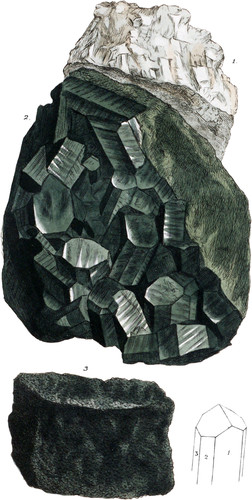 Enlarge
Enlarge
Exotic Mineralogy
Sahlite
- Syn.
- Sahlit. D’Andrada, Werner, &c.
- Malacolithe. D’Abildgaard, Haüy IV. 379.
- Proxène (in part) Haüy Tabl. 41 and 42.
- Augite β. Sahlite, Aikin 228.
- Sahlite. Bournon Catal. 76.
- Silex Salaensis, Sowerby’s List of Minerals, 8.
Augite occurs under so many different appearances that it is difficult to fix upon a character by which to distinguish Sahlite from it; if it really prove to be as Bournon and the followers of Werner assert, a distinct species; the colour suit insisted upon by the latter is of little service, since Augite is sometimes almost white; yet there is in the green varieties of Sahlite a blue cast and a kind of glaucous appearance that is not in the green Augites (see tab. 157) the different position of the nucleus, an oblique prism, in the crystal observed by Bournon would be a good character if that nucleus were not easily divisible in the diagonals of its base, producing faces corresponding with those of the nucleus of Augite in their relative position with the termination of the prism, which in Augite is found to incline upon the angle of the prism while in Sahlite it inclines upon one of the lateral faces. The only character left by which Sahlite may be known with certainty, is the facility with which it breaks in the direction of all the sides of the nucleus and of its diagonals, but more particularly in that of the terminal faces, parallel to which numerous fissures are conspicuous in all the varieties; most of the surfaces thus produced are shining hut seldom flat for any great extent; but those parallel to the terminal planes are dullest and generally flat quite across the crystal, with a peculiar lustre, and somewhat scaly surface. Augite never presents a flat fracture in this direction, but often exhibits a conchoidal cross fracture which is seldom seen in Sahlite because the other fractures are more easily made. The differences in goniometrical measures are too small and perhaps not sufficiently established to be relied upon, and if they were, it is seldom that specimens occur upon which they can be observed The nucleus according to Bournon is a rectangular 4-sided prism with its terminal planes inclined upon two of the sides at an angle of 106° 15′.
The analysis of Sahlite shews it to contain more Lime and Magnesia than is found in Augite, but the latter is so variable in its composition that little reliance can be placed on this circumstance.
| Silex | 53 |
| Magnesia | 19 |
| Argilla | 3 |
| Lime | 20 |
| Iron and Manganese | 4 |
| 99 |
Sahlite is named from Sahla in Sweden, where it is found in the silver mines; it is also abundant near Arendahl in Norway, where it is associated with Magnetic Iron, Mica, Hornblende, Carbonate of Lime, &c. It also occurs in a granular form mixed with granular Magnetic Iron and Mica at Sverdjo near Fahlun: this variety has often been called Coccolite (granular Augite) but differs from it in its foliated structure. In Scotland it also is found but mostly in masses composed of various sized crystals closely matted together and nearly white.
Fig. 1 represents a Scotch specimen from Glen Elg.
Fig. 2, a crystallized specimen from Arendahl, taken from the collection in the British Museum.
Fig. 3 the granular variety from Sverdjo.
Nos. 1 and 3 and the larger terminal plane in the outline are the primitive faces; No. 2 and the other narrow faces of the prism with the same terminal face are what would be the primitive faces if the crystal belonged to Augite instead of Sahlite.

